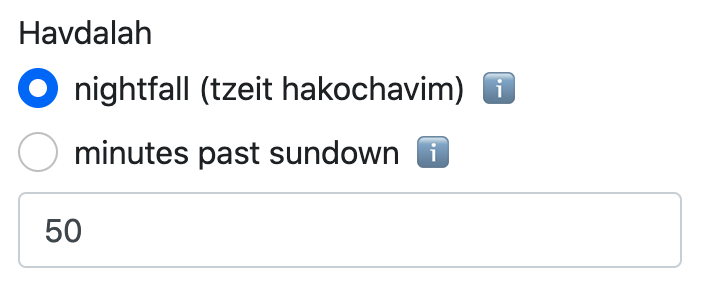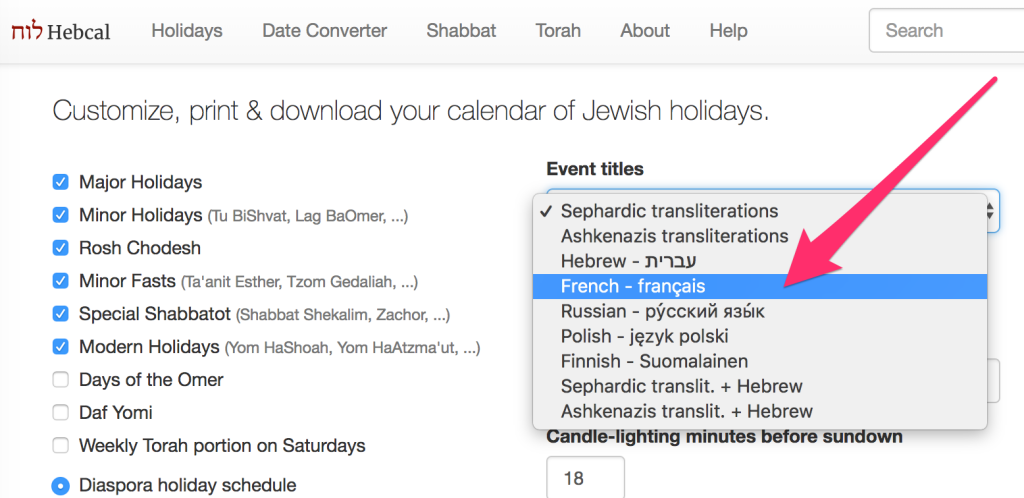Hebcal.com now offers a REST API for calculating zmanim (halachic times) for a given location.
Note that this is a web API with the same functionality as Zmanim API provided by the JavaScript @hebcal/core package. If you’re building a JavaScript application, consider using the native JS library instead of web APIs for a faster user experience.
The basic URL format is as follows:
https://www.hebcal.com/zmanim?cfg=json&geonameid=3448439&date=2021-03-23
URL format for batch query (range of dates):
https://www.hebcal.com/zmanim?cfg=json&geonameid=3448439&start=2021-01-15&end=2021-01-22
As with all Hebcal.com REST APIs:
- Both HTTP and HTTPS (HTTP/2) are supported. Although most of the Web has moved to HTTPS, if you wish to reduce CPU overhead on your client you may continue to use plain (port 80) HTTP for API requests
- We encourage HTTP caching proxies. Proper Cache-Control and Expires are generated in the response
- We support both gzip and br (brotli) compression; set the appropriate Accept-Encoding header in your request to enable
- We support HTTP Keep-Alive for multiple requests
Parameters and their meanings
- cfg=json – output JSON. Required
Location
Specify the desired location using GeoNames.org numeric ID, United States ZIP code, or latitude/longitude. This page also describes how to enable/disable the optional elevation for sunset calculation.
Date
Note the following optional date parameters and their meanings:
- date=2021-03-23 – calculate zmanim for a single date using YYYY-MM-DD format
- start=2021-01-15&end=2021-01-22 – calculate zmanim for a date range using YYYY-MM-DD format. Results will be truncated to 180 days if the end date is more than 180 days after the start date
If neither date format is specified, the API will return zmanim for today. Note that specifying the &date= parameter is preferred, because it’s more consistent, predictable, and improves cachability.
If your application needs to generate zmanim for multiple dates, it’s much more efficient to use the batch format (&start=YYYY-MM-DD&end=YYYY-MM-DD) than to make multiple API calls.
Precision
Update September 2022: an optional &sec=1 parameter may be specified to get seconds-level precision of times. The default if unspecified is to round times to the nearest minute.
Response format
The following Zmanim are included in the response:
chatzotNight– Midnight – Chatzot- Sunset plus 6 halachic hours
alotHaShachar– Dawn – Alot haShachar- Sun is 16.1° below the horizon in the morning
misheyakir– Earliest talis & tefillin – Misheyakir- Sun is 11.5° below the horizon in the morning
misheyakirMachmir– Earliest talis & tefillin – Misheyakir Machmir- Sun is 10.2° below the horizon in the morning
dawn– Civil dawn- Sun is 6° below the horizon in the morning
sunrise– Sunrise- Upper edge of the Sun appears over the eastern horizon in the morning (0.833° above horizon)
sofZmanShma– Latest Shema (Gra)- Sunrise plus 3 halachic hours, according to the Gra
sofZmanShmaMGA– Latest Shema (MGA)- Sunrise plus 3 halachic hours, according to Magen Avraham
sofZmanTfilla– Latest Shacharit (Gra)- Sunrise plus 4 halachic hours, according to the Gra
sofZmanTfillaMGA– Latest Shacharit (MGA)- Sunrise plus 4 halachic hours, according to Magen Avraham
chatzot– Midday – Chatzot- Sunrise plus 6 halachic hours
minchaGedola– Earliest Mincha – Mincha Gedola- Sunrise plus 6.5 halachic hours
minchaKetana– Preferable earliest time to recite Minchah – Mincha Ketana- Sunrise plus 9.5 halachic hours
plagHaMincha– Plag haMincha- Sunrise plus 10.75 halachic hours
sunset– Sunset- When the upper edge of the Sun disappears below the horizon (0.833° below horizon)
dusk– Civil dusk- Sun is 6° below the horizon in the evening
beinHaShmashos– Bein Hashemashot / Twilight- 13.5 minutes prior to tzeit (nightfall) when the sun is 7.083° below horizon
tzeit7083deg– Nightfall (3 medium stars) – Tzeit 7.083°- When 3 medium stars are observable in the night sky with the naked eye (sun 7.083° below the horizon)
tzeit85deg– Nightfall (3 small stars) – Tzeit 8.5°- When 3 small stars are observable in the night sky with the naked eye (sun 8.5° below the horizon)
tzeit42min– Nightfall (3 medium stars) – Tzeit 42 minutes- When 3 medium stars are observable in the night sky with the naked eye (fixed 42 minutes after sunset)
tzeit50min– Nightfall (3 small stars) – Tzeit 50 minutes- When 3 small stars are observable in the night sky with the naked eye (fixed 50 minutes after sunset)
tzeit72min– Nightfall (Rabbeinu Tam) – Tzeit 72 minutes- When 3 small stars are observable in the night sky with the naked eye (fixed 72 minutes after sunset)
Licensing
Content generated by the Hebcal.com web APIs is licensed under a Creative Commons Attribution 4.0 International License. This means that you can use you are free to copy and redistribute the material in any medium or format as long as you give appropriate credit to Hebcal.com.
Example output (single date)
{
"date": "2021-03-23",
"location": {
"latitude": -23.5475,
"longitude": -46.63611,
"il": false,
"tzid": "America/Sao_Paulo",
"name": "São Paulo, Sao Paulo, Brazil",
"cc": "BR",
"geoid": 3448439,
"geo": "geoname",
"geonameid": 3448439,
"asciiname": "Sao Paulo",
"admin1": "Sao Paulo",
"population": 10021295
},
"times": {
"chatzotNight": "2021-03-23T00:13:00-03:00",
"alotHaShachar": "2021-03-23T05:05:00-03:00",
"misheyakir": "2021-03-23T05:25:00-03:00",
"misheyakirMachmir": "2021-03-23T05:31:00-03:00",
"dawn": "2021-03-23T05:49:00-03:00",
"sunrise": "2021-03-23T06:11:00-03:00",
"sofZmanShma": "2021-03-23T09:12:00-03:00",
"sofZmanShmaMGA": "2021-03-23T08:36:00-03:00",
"sofZmanTfilla": "2021-03-23T10:12:00-03:00",
"sofZmanTfillaMGA": "2021-03-23T09:48:00-03:00",
"chatzot": "2021-03-23T12:13:00-03:00",
"minchaGedola": "2021-03-23T12:43:00-03:00",
"minchaKetana": "2021-03-23T15:44:00-03:00",
"plagHaMincha": "2021-03-23T16:59:00-03:00",
"sunset": "2021-03-23T18:14:00-03:00",
"dusk": "2021-03-23T18:37:00-03:00",
"tzeit7083deg": "2021-03-23T18:41:00-03:00",
"tzeit85deg": "2021-03-23T18:48:00-03:00",
"tzeit42min": "2021-03-23T18:56:00-03:00",
"tzeit50min": "2021-03-23T19:04:00-03:00",
"tzeit72min": "2021-03-23T19:26:00-03:00"
}
}
Sample output (batch)
{
"date": {
"start": "2021-01-15",
"end": "2021-01-18"
},
"location": {
"latitude": -23.5475,
"longitude": -46.63611,
"il": false,
"tzid": "America/Sao_Paulo",
"name": "São Paulo, Sao Paulo, Brazil",
"cc": "BR",
"geoid": 3448439,
"geo": "geoname",
"geonameid": 3448439,
"asciiname": "Sao Paulo",
"admin1": "Sao Paulo",
"population": 10021295
},
"times": {
"chatzotNight": {
"2021-01-15": "2021-01-15T00:16:00-03:00",
"2021-01-16": "2021-01-16T00:16:00-03:00",
"2021-01-17": "2021-01-17T00:17:00-03:00",
"2021-01-18": "2021-01-18T00:17:00-03:00"
},
"alotHaShachar": {
"2021-01-15": "2021-01-15T04:18:00-03:00",
"2021-01-16": "2021-01-16T04:19:00-03:00",
"2021-01-17": "2021-01-17T04:20:00-03:00",
"2021-01-18": "2021-01-18T04:21:00-03:00"
},
"misheyakir": {
"2021-01-15": "2021-01-15T04:41:00-03:00",
"2021-01-16": "2021-01-16T04:42:00-03:00",
"2021-01-17": "2021-01-17T04:43:00-03:00",
"2021-01-18": "2021-01-18T04:44:00-03:00"
},
"misheyakirMachmir": {
"2021-01-15": "2021-01-15T04:48:00-03:00",
"2021-01-16": "2021-01-16T04:49:00-03:00",
"2021-01-17": "2021-01-17T04:50:00-03:00",
"2021-01-18": "2021-01-18T04:50:00-03:00"
},
"dawn": {
"2021-01-15": "2021-01-15T05:09:00-03:00",
"2021-01-16": "2021-01-16T05:09:00-03:00",
"2021-01-17": "2021-01-17T05:10:00-03:00",
"2021-01-18": "2021-01-18T05:11:00-03:00"
},
"sunrise": {
"2021-01-15": "2021-01-15T05:33:00-03:00",
"2021-01-16": "2021-01-16T05:34:00-03:00",
"2021-01-17": "2021-01-17T05:35:00-03:00",
"2021-01-18": "2021-01-18T05:36:00-03:00"
},
"sofZmanShma": {
"2021-01-15": "2021-01-15T08:55:00-03:00",
"2021-01-16": "2021-01-16T08:55:00-03:00",
"2021-01-17": "2021-01-17T08:56:00-03:00",
"2021-01-18": "2021-01-18T08:56:00-03:00"
},
"sofZmanShmaMGA": {
"2021-01-15": "2021-01-15T08:19:00-03:00",
"2021-01-16": "2021-01-16T08:19:00-03:00",
"2021-01-17": "2021-01-17T08:19:00-03:00",
"2021-01-18": "2021-01-18T08:20:00-03:00"
},
"sofZmanTfilla": {
"2021-01-15": "2021-01-15T10:02:00-03:00",
"2021-01-16": "2021-01-16T10:02:00-03:00",
"2021-01-17": "2021-01-17T10:03:00-03:00",
"2021-01-18": "2021-01-18T10:03:00-03:00"
},
"sofZmanTfillaMGA": {
"2021-01-15": "2021-01-15T09:38:00-03:00",
"2021-01-16": "2021-01-16T09:38:00-03:00",
"2021-01-17": "2021-01-17T09:38:00-03:00",
"2021-01-18": "2021-01-18T09:39:00-03:00"
},
"chatzot": {
"2021-01-15": "2021-01-15T12:16:00-03:00",
"2021-01-16": "2021-01-16T12:16:00-03:00",
"2021-01-17": "2021-01-17T12:17:00-03:00",
"2021-01-18": "2021-01-18T12:17:00-03:00"
},
"minchaGedola": {
"2021-01-15": "2021-01-15T12:50:00-03:00",
"2021-01-16": "2021-01-16T12:50:00-03:00",
"2021-01-17": "2021-01-17T12:50:00-03:00",
"2021-01-18": "2021-01-18T12:50:00-03:00"
},
"minchaKetana": {
"2021-01-15": "2021-01-15T16:11:00-03:00",
"2021-01-16": "2021-01-16T16:11:00-03:00",
"2021-01-17": "2021-01-17T16:11:00-03:00",
"2021-01-18": "2021-01-18T16:11:00-03:00"
},
"plagHaMincha": {
"2021-01-15": "2021-01-15T17:35:00-03:00",
"2021-01-16": "2021-01-16T17:35:00-03:00",
"2021-01-17": "2021-01-17T17:35:00-03:00",
"2021-01-18": "2021-01-18T17:35:00-03:00"
},
"sunset": {
"2021-01-15": "2021-01-15T18:59:00-03:00",
"2021-01-16": "2021-01-16T18:58:00-03:00",
"2021-01-17": "2021-01-17T18:58:00-03:00",
"2021-01-18": "2021-01-18T18:58:00-03:00"
},
"dusk": {
"2021-01-15": "2021-01-15T19:23:00-03:00",
"2021-01-16": "2021-01-16T19:23:00-03:00",
"2021-01-17": "2021-01-17T19:23:00-03:00",
"2021-01-18": "2021-01-18T19:23:00-03:00"
},
"tzeit7083deg": {
"2021-01-15": "2021-01-15T19:29:00-03:00",
"2021-01-16": "2021-01-16T19:29:00-03:00",
"2021-01-17": "2021-01-17T19:28:00-03:00",
"2021-01-18": "2021-01-18T19:28:00-03:00"
},
"tzeit85deg": {
"2021-01-15": "2021-01-15T19:36:00-03:00",
"2021-01-16": "2021-01-16T19:35:00-03:00",
"2021-01-17": "2021-01-17T19:35:00-03:00",
"2021-01-18": "2021-01-18T19:35:00-03:00"
},
"tzeit42min": {
"2021-01-15": "2021-01-15T19:41:00-03:00",
"2021-01-16": "2021-01-16T19:40:00-03:00",
"2021-01-17": "2021-01-17T19:40:00-03:00",
"2021-01-18": "2021-01-18T19:40:00-03:00"
},
"tzeit50min": {
"2021-01-15": "2021-01-15T19:49:00-03:00",
"2021-01-16": "2021-01-16T19:48:00-03:00",
"2021-01-17": "2021-01-17T19:48:00-03:00",
"2021-01-18": "2021-01-18T19:48:00-03:00"
},
"tzeit72min": {
"2021-01-15": "2021-01-15T20:11:00-03:00",
"2021-01-16": "2021-01-16T20:10:00-03:00",
"2021-01-17": "2021-01-17T20:10:00-03:00",
"2021-01-18": "2021-01-18T20:10:00-03:00"
}
}
}


